Small reasoning applied to a media content on COP27
by Christian Seyve
On November 7, 2022, I suddenly felt very interested in a map published by « The Great Continent » (Ref. 1, Fig. 1). This was the centerpiece of a paper entitled: What’s at stake at the COP27? I was instantly struck by the message transmitted by this image.
It represented on a world map, the participation of the government’s representatives, in the opening ceremony of the conference. It showcased the involvement of these countries, in finding solutions to climate challenges. But for me, it also brought to light another reality: that a majority of representatives of the world states chose not to take part in COP27!
I did not guess at that time, that it was a harbinger of the disappointing results, obtained two weeks later…The purpose of this note is to analyze, then to complement this image, and to try to answer to the questions it raises.
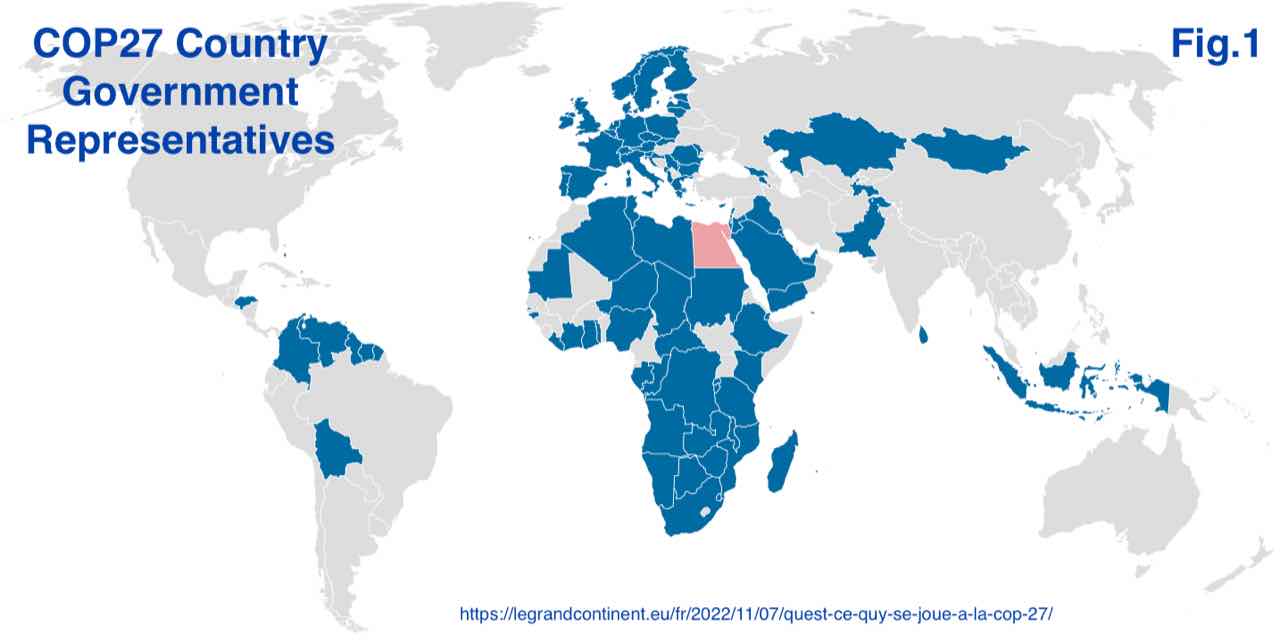
Let’s first focus on what the image conveys, or suggests, to anyone with a basic knowledge about the geography (and hence of geopolitics), the stakes, and the constraints inherent in the subject:
– None of the North American or South American representatives, with substantial fossil fuel productions or reserves, were present (the President of the USA was busy with the midterm elections, the results of which should affect any future green deal; he visited the COP afterwards);
– None of the representatives of the most populated countries in Asia, or the Middle East ones with the greatest reserves of hydrocarbons or coal on the planet were present (excepted Saudi Arabia);
– Ironically, none of the countries (except for the DRC, and South Africa) that have the largest critical mineral reserves were present. Similar observation can be done with those that may have the know-how, and/or the industrial capacity altogether, that will help find the solutions to manage the future climate challenges;
– Finally, it appeared more like an illustration of a classical North-South conference where Europe seemed quite alone with Africa, and few O&G producers like Indonesia (Brazil’s president appeared lately at the conference).
Thus, we see that the statement: “A good sketch is better than a long speech” applied only partially to our example. We need more comments, and additional images, in order to truly understand what was going on.
As we are interested in the objectives of the COP27th conference, let us rely on the information given by some people particularly invested in the subject, as presented for example, on the website « Climate ADAPT.eu » (Ref. 2):
“The 27th session of the Conference of the Parties (COP27) to the UNFCCC is about mitigation, adaptation and finance. The Global Goal on Adaptation was one of the significant outcomes of COP26. The aim of COP27 is to make urgent progress and urge all Parties to show the necessary political will to capture and assess our progress in increasing resilience and assist the most vulnerable communities.”
With these objectives in mind, we can consider three maps that are published by the website « Our World in data » (Refs. 3, 4, 5; Figs. 2, 3, 4). They will help us highlight the complexity of the issues, that the Fig. 1 had eluded.
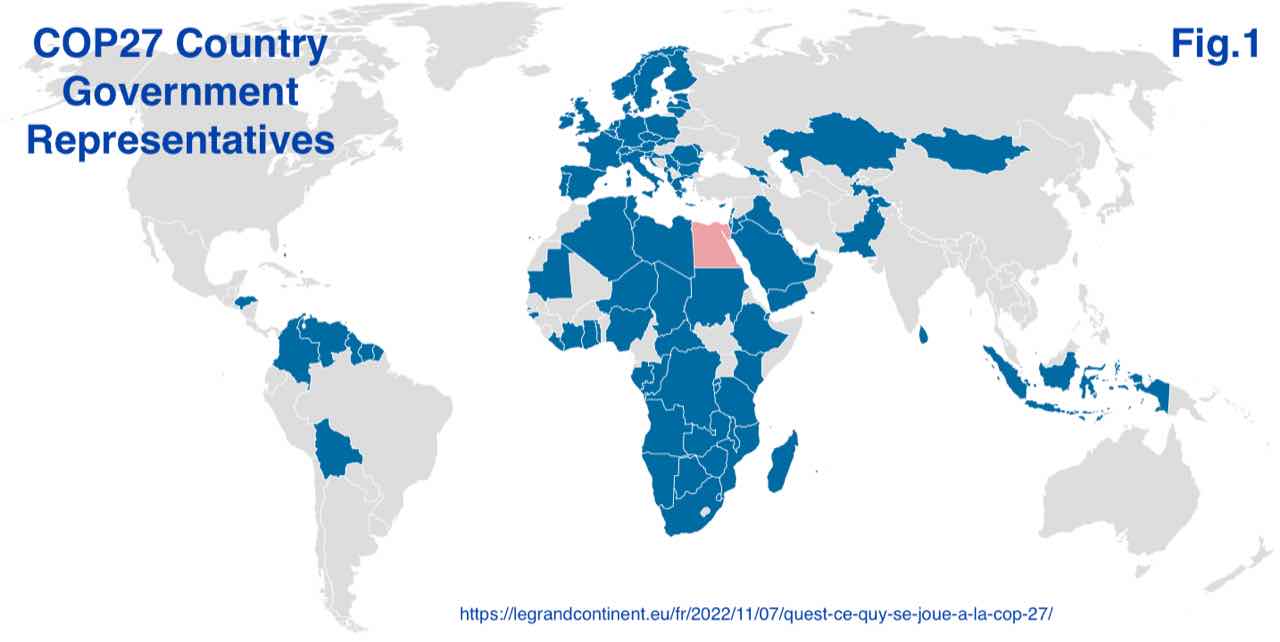
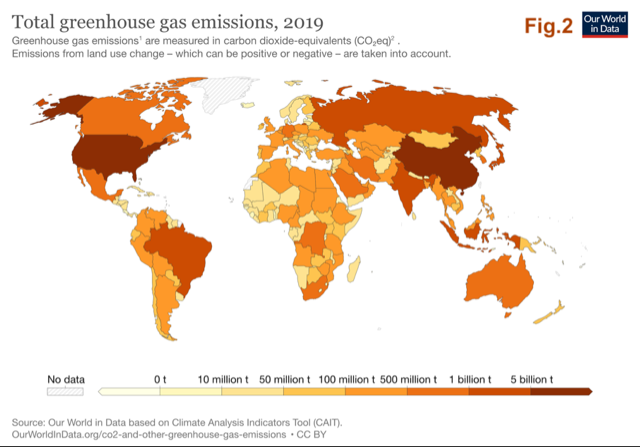
These two maps complement each other quite well. COP27 government’s representatives should have an influence on one third of the GHG world emissions (as produced in 2019). As for the ten biggest GHG producers, only Germany (6°), Indonesia (10°), and Saudi Arabia (9°), were represented by their government’s officials.
Maybe we should say « several sketches are better than a long speech”? If we add to our visuals two more maps, illustrating the “GDP per capita, 2020” by countries (Fig. 3), and the “Electricity generation from low carbon sources, 2021” (Fig. 4), the chasm that separates the populations of the globe, and the COP27, widens further.
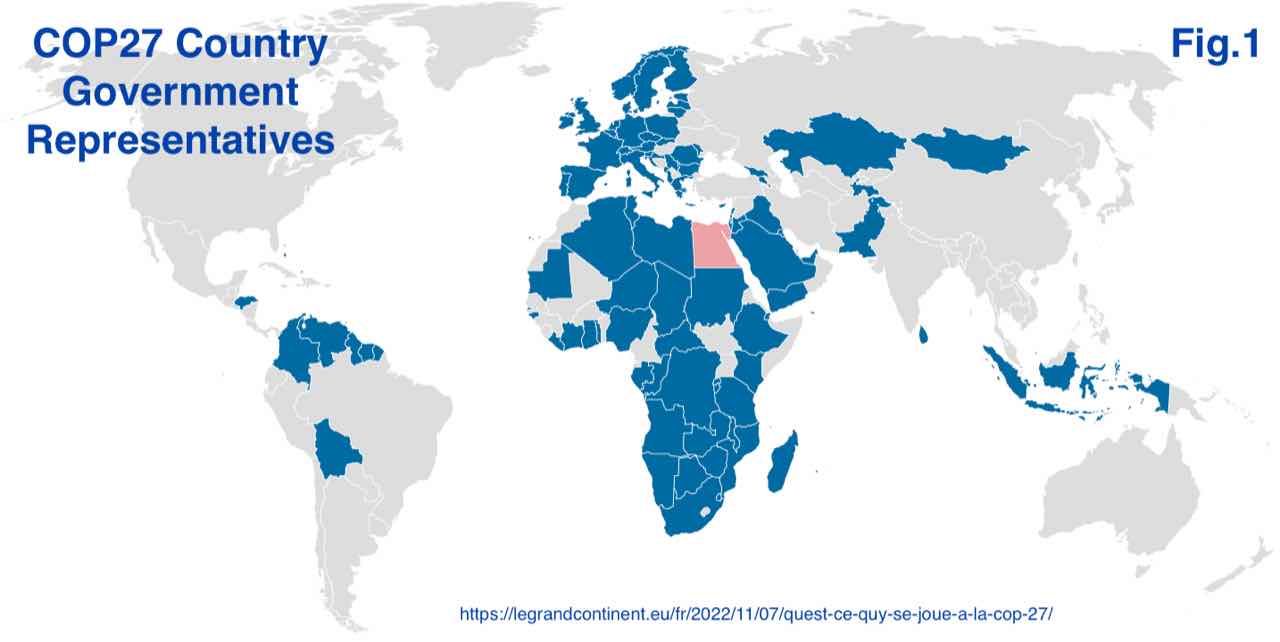
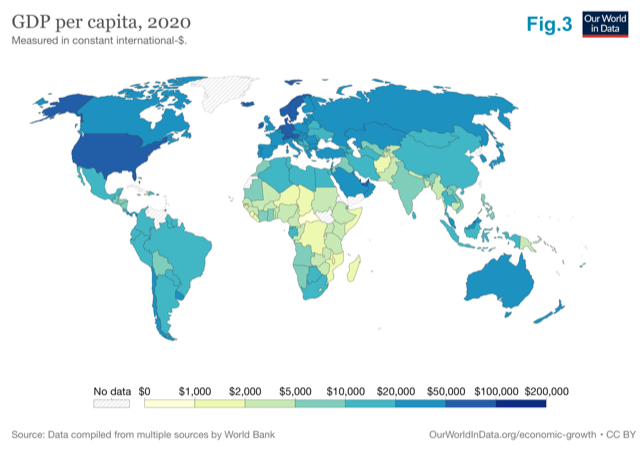
The poorest countries, with the lowest GHG emissions per capita, and the weakest low carbon electricity generation, were keener than others, to participate to the COP27 conference. They had come to demand compensation both for “the climatic damages caused historically by the northern countries”, and for “the financing of the efforts demanded in the use of virtuous energy resources, sometimes instead of using their own fossil fuels”. Since 2020, the subject came up in the COP assemblies: $100 billion per year should be dedicated to it. In reality, barely $20 billion have been allocated in two years, causing a lot of frustrations.
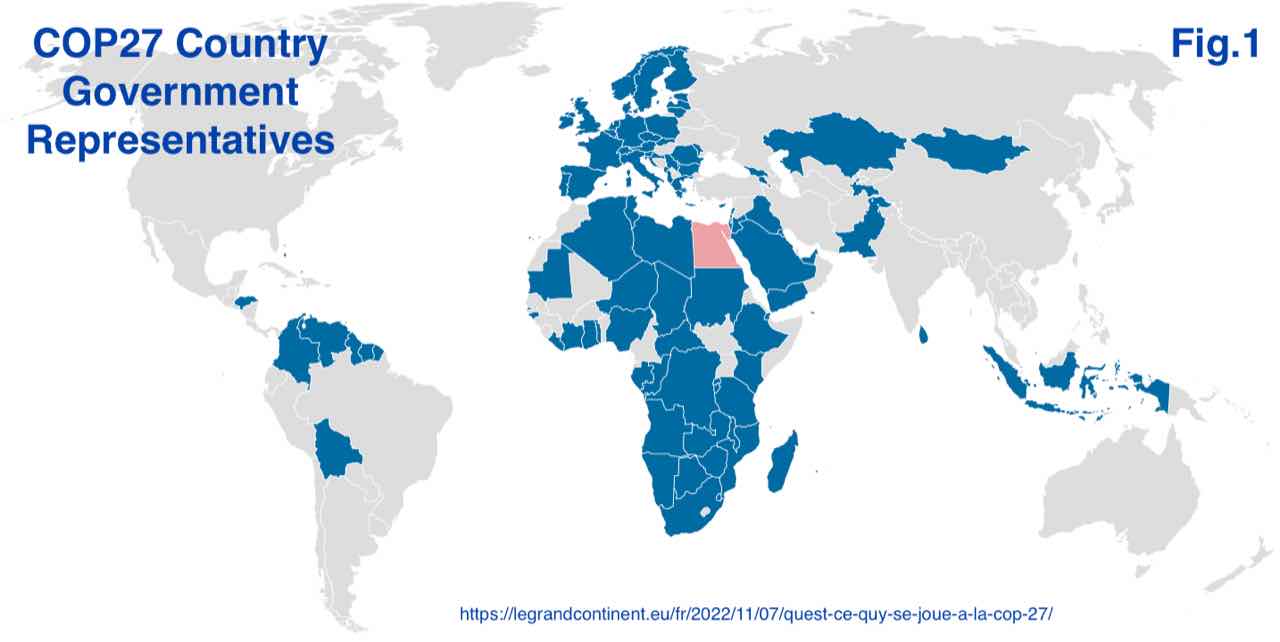
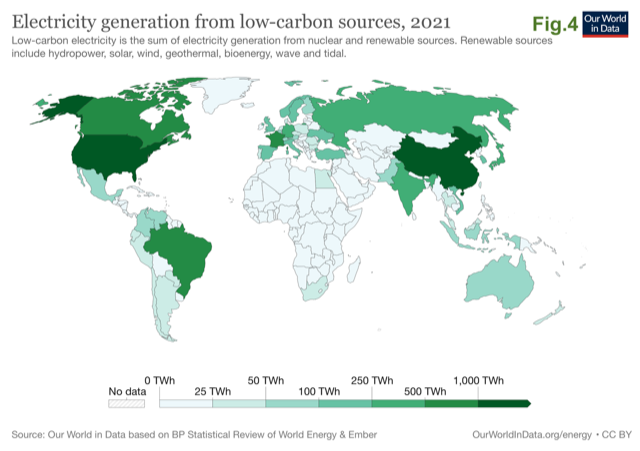
The geopolitical events of 2021, the failed objectives of past COPs, always reiterated but never respected, and the deterioration of the economic contexts of the developing countries, after the COVID crisis, explain the mixed enthusiasm of the governments of the South. Crucial points were latent at the start of the conference:
- How could Europe hope to be credible, after having demonstrated in the management of its own ongoing energy crisis, so much propensity to reopen coal-fired power plants, and to renegotiate in the haste, a lot of gas contracts? (With Mediterranean, Middle East, US, and African producers).
- How those with newly discovered (Gas and Oil) reserves should agree to leave them unexploited without having any assurance (for years!) of financial compensation? They were more incline to interpret the « Do what I say, not as I do », to defend their own interest, following the UK example, notably absent at the conference, but which has created new conditions to boost Oil & Gas activities in its North Sea sector.
It’s time now to enrich our comments with other data. To keep ourselves in the same map comparison method, why not trying to illustrate the contexts, constraints, and developments of the COP27 final main resolutions
The COP27 achievements can be summarized in three essential points
- The COP26 objective of GHG emissions reduction, in order to match with the 1,5°C degree goal, was finally saved. Even if its scientific feasibility was deeply questioned.
- The compensatory measures requested by the poorest countries have found a new financing plan. Even if it has not been properly defined.
Yet, looking at the way each country is reacting to the paucity of gas and/or electricity, in Europe itself, and without the support of the main GHG world producers, how the essential point of the climate conference, “keeping the 1,5°C on track”, could be respected in the years to come?
The second COP27 achievement, which deals with the financial support of the poorest countries, is probably easier said than done. The financial plan has not been precisely implemented. It is less sure either, because it will need huge money creation, and more debts. Something that it is difficult to set up during inflation times. An above all, because most of the OECD countries are already overwhelmed by their debt, as it was illustrated by The Economist map (Ref. 6, Fig. 5), ten years ago, before the COVID huge expenditures. The main debate being: Is China a developing country or a rich country? And if so, should it be ready to contribute to the package of $100 billion per year, to help the poorest countries? Not so sure…
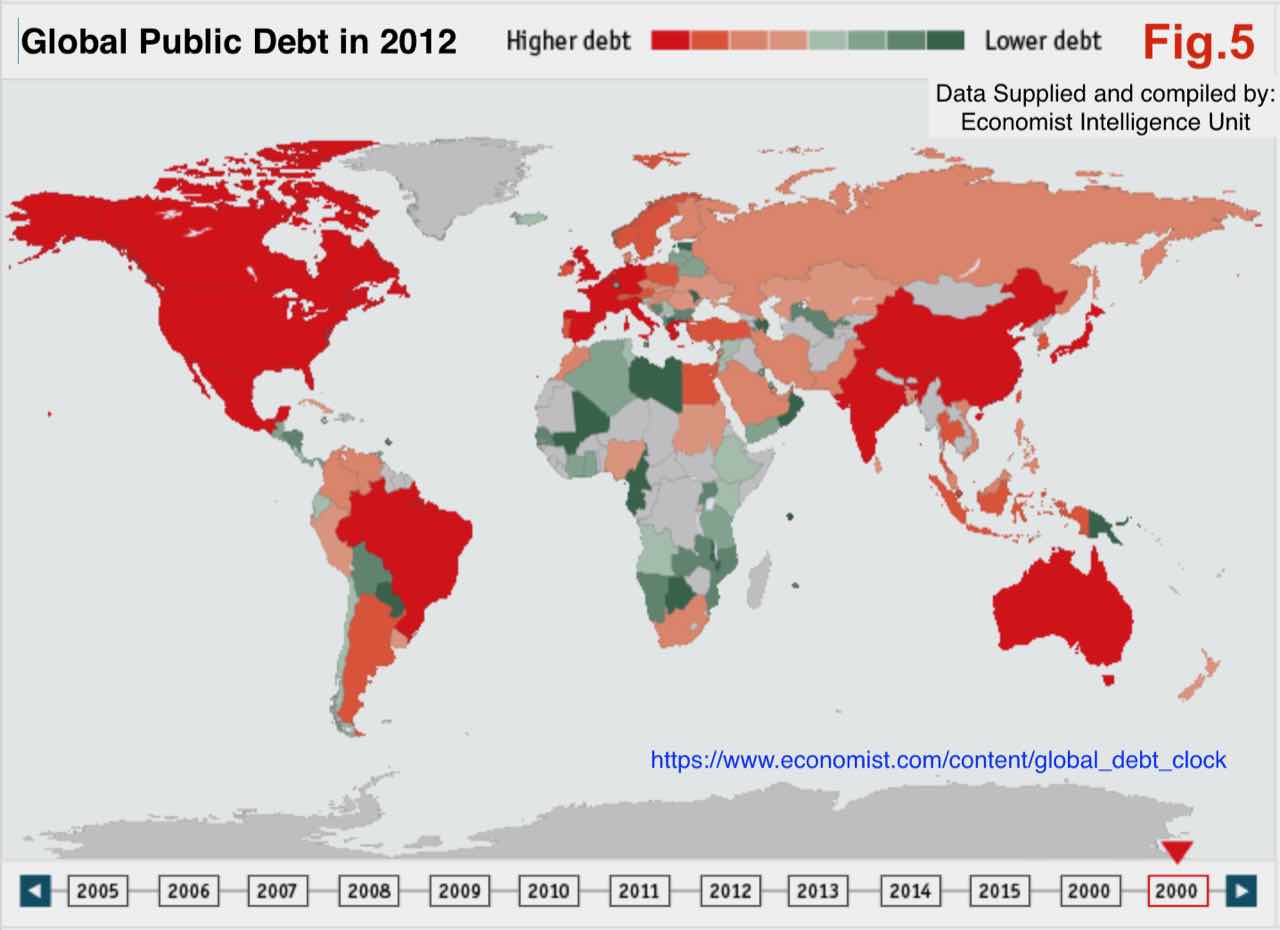
One more time, the comparison of the debt’s maps, with the COP27 head of states representative map, gives some clues to understand the participatory doubt, of some developing states, and also of some richest countries, in the debates. The COVID “degrees of deficit” map (Ref. 7, Fig. 6), produced in 2020 by the World Economic Forum, is not here to reassure them either. Richer countries have spent money massively, with priority for their populations during the COVID crisis. Their willingness to do so for climatic reasons, avoiding the development of their population’s basic needs, remains to be proven. At least, those that were absent at the COP27, have other objectives in mind.
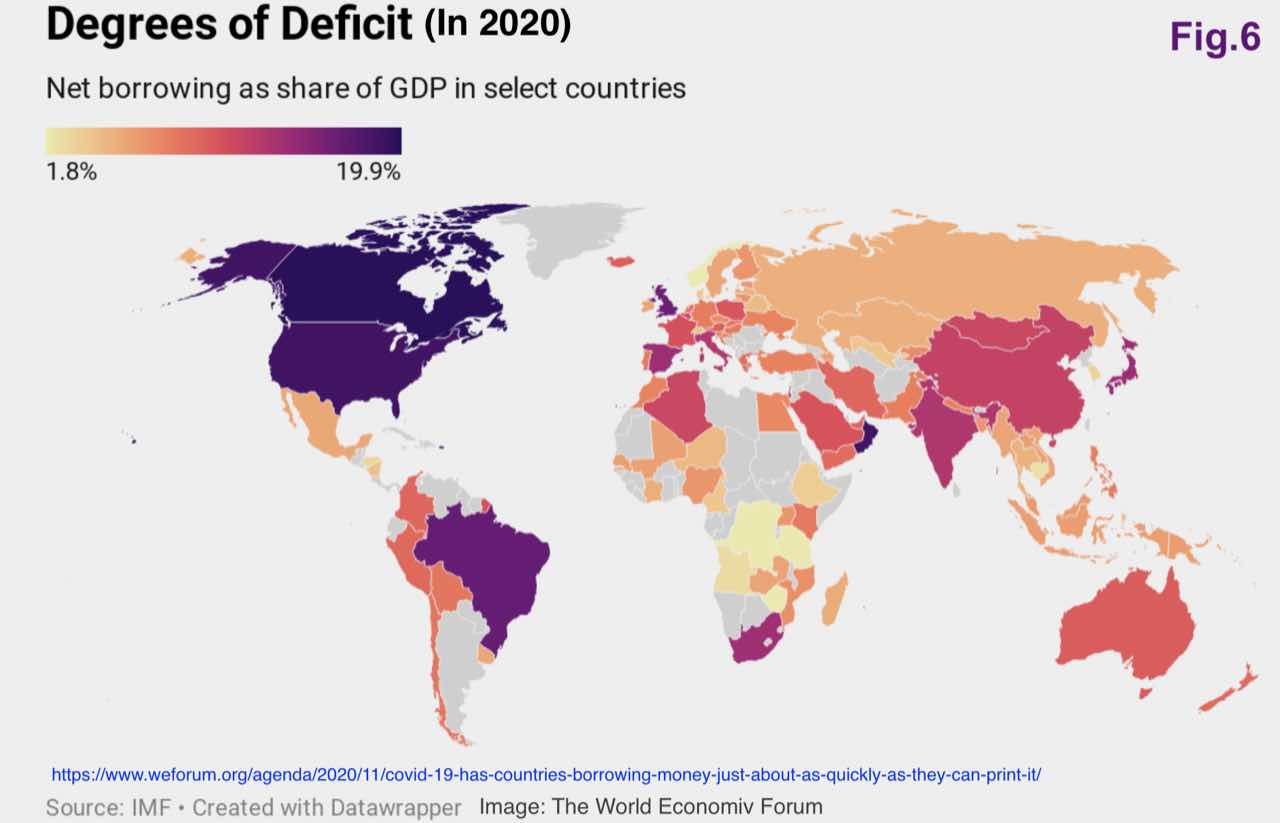
3. The COP27 third achievement deals of course with the Energy Transition issue and the willingness to develop Low Carbon energy alternatives (using photovoltaic solar and aeolian electricity instead of fossil energy resources).
Here comes another type of deficits: those linked to the huge needs of critical mineral elements to develop the new technologies required by the Green Deal goals of Carbon Neutrality by 2050.
Are those goals realistic? The EU map (Ref. 8, Fig. 7) which was reported in 2020, dealing with some raw materials, highlight the question. The report conclusion? It is urgent to come back to mining projects in Europe… Not so sure either, owing to the common societal unacceptability. And above all, resources are elsewhere anyway.
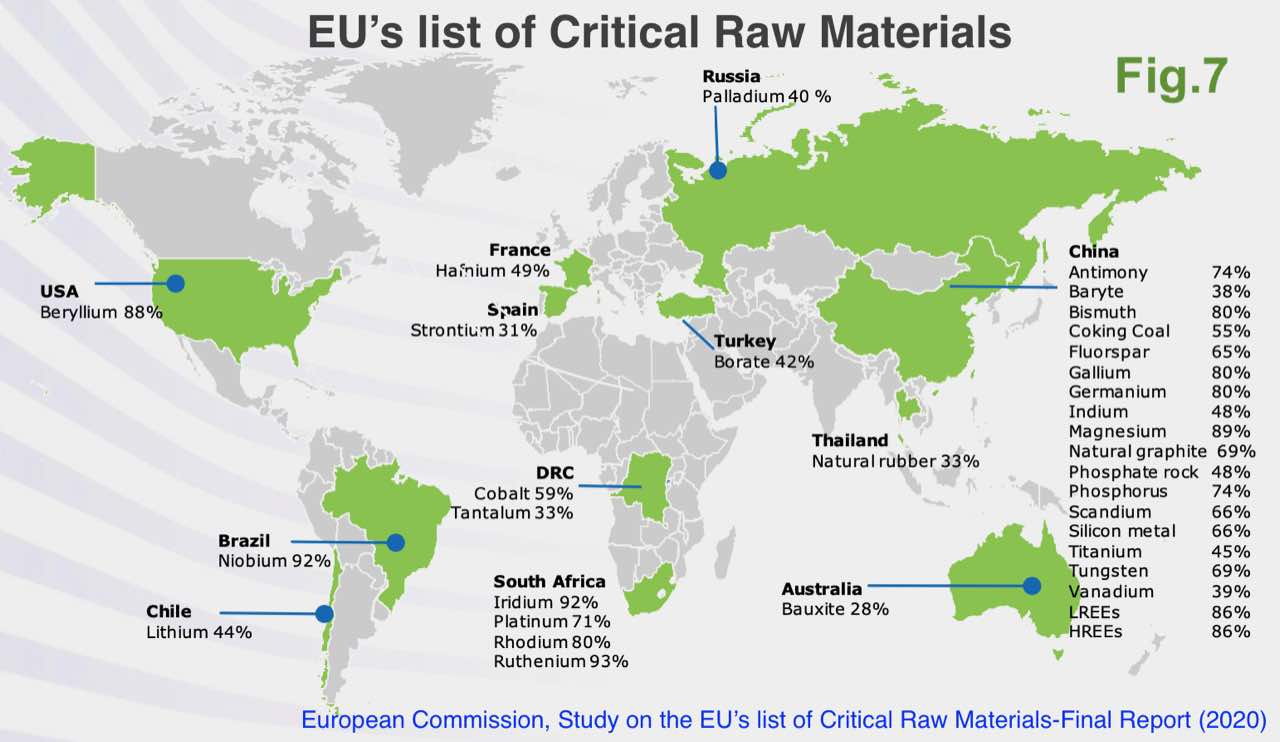
One may argue (or hope) that the situation could change in the future…But the reality is different.
The last map that we should scrutinize to enrich or reasoning, has been produced by the website “Visualcapitalist” (Ref .9, Fig. 7). This interactive map compares the Li-ION battery raw material supply rankings of the world producing countries todays, and in 2025. Even if some trends tend to change some ranks, the key players will remain the same, in the short term of course, and in the mid-term perspectives also.
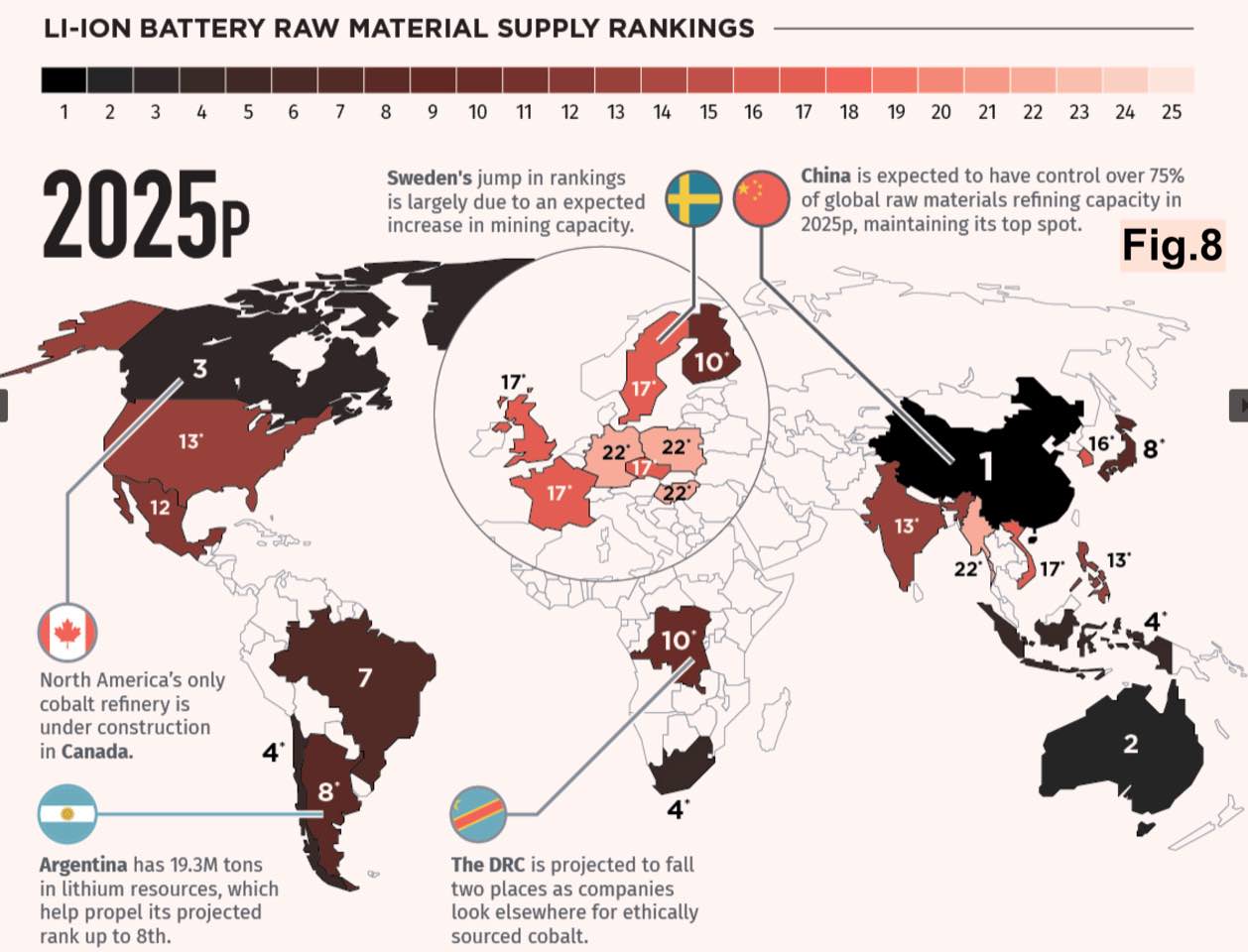
Which conclusions could we set up?
Dealing with the idea that “A good sketch is better than a long speech” we may keep in mind that:
Any sketch is of course useful to support any presentation, but it is also by essence necessarily limited, and not totally efficient. Our first map is a good illustration of the “one sketch limit”!
It is a good illustration also of the partial view, that one drawing, image, or photo, can support.
A method that is commonly used in the media to boost the sensational aspect of the information.
It needs to be completed by comments, and most of the times by other sketches.
As the IMdR (Institut pour la Maîtrise des Risques) explained (Ref. 10): it’s the balance between the presentation methods, that may facilitate the understanding, and give space for new ideas to appear.
Dealing with the COP27 results, not being a diplomat, I should only have the right to ask some questions:
Who would contest that the geographical constraints are inevitable, and that they represent probably the worst element that will limit any future COP resolution? The geological distribution of critical resources associated with the geopolitical and economical confrontations will play a major role in the implementation of any decision. It will continue to influence greatly the next COPs (either in Dubai next year, or in Amazonia in 2030).
Besides, we are probably witnessing, with the present European energy crisis, the return of some old evidences:
– That there is today, no alternative to classical energy sources, whatever your degree of “climate change anxiety”, your aversion to nuclear civil power, or your willingness to save the environment in 2100.
– That secured geopolitical mineral and energetical resources are vital for any country, and that consequently, everyone will be ready to fight for that. Keeping this in mind, the China astounding dominance in solar panel supply chain, as illustrated by the Visualcapitalist website (Fig. 9), should worry.
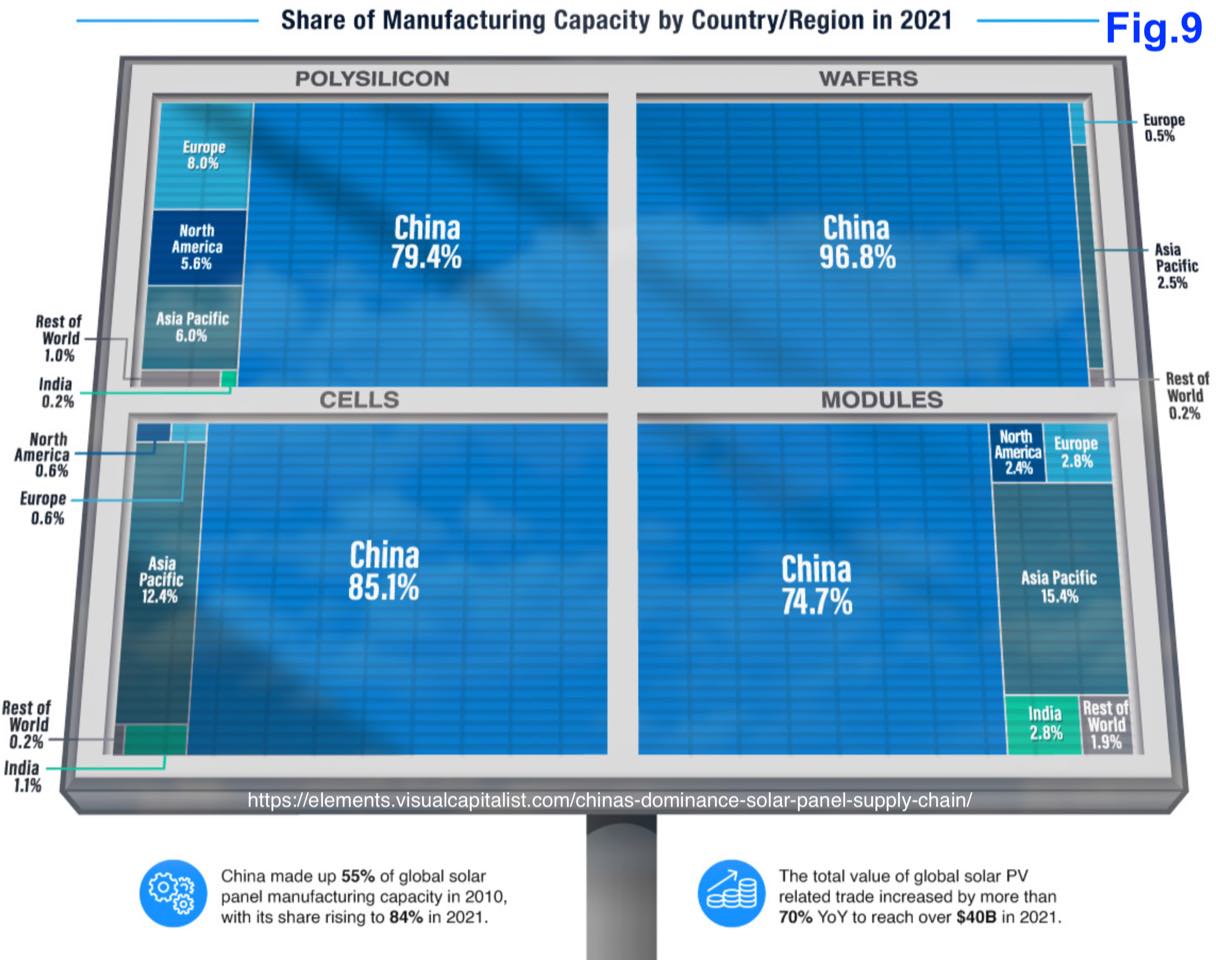
– And, there will be probably also another great consequence for the African countries in which Oil & Gas resources have been recently discovered (Ivory coast, Mauritania, Mozambique, Niger, Uganda, Namibia, Senegal, South Africa and others…): The present-day new awareness should create more favorable conditions to support their developments.
Of course, it is impossible to reach to a definitive consensus on such sensitive topics. Everybody has his opinion, (and sometimes his religion) dealing with the Climate Change and the Energy Transition. As for myself, I think that we may foresee that the European crisis and its coming recession will deeply impact the opinions and the future governments decisions:
- Sobriety, resilience, and penuries will probably be tested in full scale, shortly.
- Resilience is a concept for the wealthiest (regardless of its merits).
- Restrictions are the reality of peoples (whatever their possible blindness).
Through globalization, and a cheap, controlled Chinese factory, we dreamed of an immaterial world. But the world has changed and the intangible has not overcome the constraints of geography, matter, local cultures and politics. As it is said on the “visual capitalist website” (Ref. 9): we live in a material world, and its geographical and geological constraints are more and more evident. We need Energy. We need Minerals. Such evidences cannot be ignored. And resilience cannot be organized with the risk of imposing restrictions.
As a final conclusion, I cannot resist to invite you to test your curiosity towards some ideas defended by Jean-Baptiste FRESSOZ in a short conference recorded on YouTube (Ref. 11), a month ago. As an Historian of Sciences, he may help us to consider another key question:
What would be the meaning of all these hot debates, if the Energy Transition was a modern Utopia?
———————————————————————————————————————-
I would like to thank all of the institutions and websites I quoted and used to prepare this text. Without their publications, I would not have had the opportunity to imagine this short exercise and, publish it. Very special thanks to Daniel MICHOUX for having reviewed the English text. I would add, that even if we cannot pretend to be a specialist in so many domains, it is always interesting to try to cross validate the interferences that exist between them. Maps are important tools for this purpose. And I think it is our duty to address such kind of questioning. At last, of course I have necessarily set out my beliefs in this text. I shall welcome, and integrate with a great pleasure, your contradictory opinions and arguments.
————————————————————————————————————————-
References
(1) https://legrandcontinent.eu/fr/2022/11/07/quest-ce-quy-se-joue-a-la-cop-27/
(2) https://climate-adapt.eea.europa.eu/en/more-events/un-climate-change-conference-2022-unfccc-cop-27
(3) https://ourworldindata.org/co2-emissions
(4) https://ourworldindata.org/grapher/gdp-per-capita-worldbank
(5) https://ourworldindata.org/grapher/low-carbon-electricity
(6) https://www.economist.com/content/global_debt_clock
(9) https://elements.visualcapitalist.com/ranked-top-25-nations-for-battery-metals/
(10) https://www.imdr.eu/offres/doc_inline_src/818/Fiche_stereotypeaction_Croquis_discours.pdf
(11) Jean-Baptiste FRESSOZ, De l’utopie atomique au déni climatique. Conference, 2022/10/05 (in French).
List of Figures
(1) COP27 Country Government Representatives (Pays représentés par leurs chefs d’État, de gouvernement ou vice-présidents à l’ouverture de la COP27 – Le Grand Continent, 2022/11/07)
(2) Total greenhouse gas (GHG) emissions, 2019 (Our World in Data)
(3) GDP per capita, 2020 (Our World in Data)
(4) Electricity generation from low carbon sources, 2021 (Our World in Data)
(5) Global Public Debt, in 2012 (The Economist Intelligence Unit)
(6) Degrees of Deficit (linked to COVID crisis), in 2021 (World Economic forum)
(7) EU’s list of Critical Raw Material 2020 (European Commission Report)
(8) Li-Ion battery raw material supply rankings, 2025 Projection (Visualcapitalist)
(9) Share of solar panels manufacturing capacity by country/region in 2021 (Visualcapitalist)
You could use the same argument to say that France hasn’t participated in the Fifa World Cup in Qatar because Emmanuel Macron hasn’t been present at the opening ceremony.
The US, China, India, and almost all other UNFCCC signatory countries have been very present at the COP. Media are full of reports about a meeting between the US and Chinese delegations at the COP, for example. Give us a break, be serious for a second. Thanks.
@Anton 17-12 10:46 :
Which are the most serious analysis of FACTS in here ?
Far from scientific exchanges, all the COP27 meetings among world leaders are just DIPLOMATIC habits… side by side with contests from a huge bunch of ideologists and NGO activists !
All BRICS countries – wherein most attendees don’t believe in COPs spéculatives findings – remain determined to meet their essential needs and conduct their own axis for their national population development and well being. Means billions of terrestrial lifes ! There, diplomacy has one key mission : defend national stakes and interests !
Does the « United Nations » truly respond these key, vital factors ? In search of a true answer, let’s observe the sad realities across the world… and most ineffective bureaucracies !
It’s clear that COPs objectives target only ONE request : dump billions ($ 100 bn/year) from developed countries down to those who claim CO2 is adverse to their survival…
Let’s recognize this article from author Christian Seyve is very original !
For the first time, one tries to correlate public FACTS throughout these educational maps. Facts of life, right ?
Dear Anton : Comments after comments, whatever the subjects developped on this S-C-E site, you never contribute but object and oppose ! Where does remain your open mind ?
Sincerely, from another accasional author
ce texte est un très bon exemple de recherche totale et d’analyse prudente.